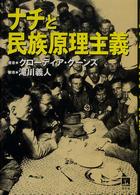- ホーム
- > 洋書
- > 英文書
- > History / World
Full Description
An exploration of how the image and idea of the dragon has evolved through history
How did the dragon get its wings? Everyone in the modern West has a clear idea of what a dragon looks like and of the sorts of stories it inhabits, not least devotees of the fantasies of J. R. R. Tolkien, J. K. Rowling, and George R. R. Martin. A cross between a snake and some fearsome mammal, often sporting colossal wings, they live in caves, lie on treasure, maraud, and breathe fire. They are extraordinarily powerful, but even so, ultimately defeated in their battles with humans. What is the origin of this creature?
The Dragon in the West is the first serious and substantial account in any language of the evolution of the modern dragon from its ancient forebears. Daniel Ogden's detailed exploration begins with the drakōn of Greek myth and the draco of the dragon-loving Romans, and a look at the ancient world's female dragons. It brings the story forwards though Christian writings, medieval illustrated manuscripts, and the lives of dragon-duelling saints, before concluding with a study of dragons found in the medieval Germanic world, including those of the Anglo-Saxon Beowulf and the Norse sagas.
Contents
Introduction
Part One: Heroes
1: Drak=on: The Classical Dragon
2: Draco: The Roman Dragon
3: Drakaina: The She-dragon
4: From Worm to Wyvern: The Evolution of the Western Dragon
Part Two: Saints
5: Scripture and Shape
6: The Etiquette of the Saintly Dragon Fight (i): Its Principal Narrative Course
7: The Etiquette of the Saintly Dragon Fight (ii): Some Important Narrative Subroutines
8: Close to the Point of Origin: Lucian's Chaldaean Snake-blaster
9: Theodore and George: Two Military Saints in Context
Part Three: Vikings
10: Worms (Still) and Wyverns: The Form of the Germanic Dragon
11: To the River and Back: The Etiquette of the Germanic Dragon Fight
Conclusion







